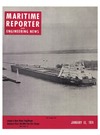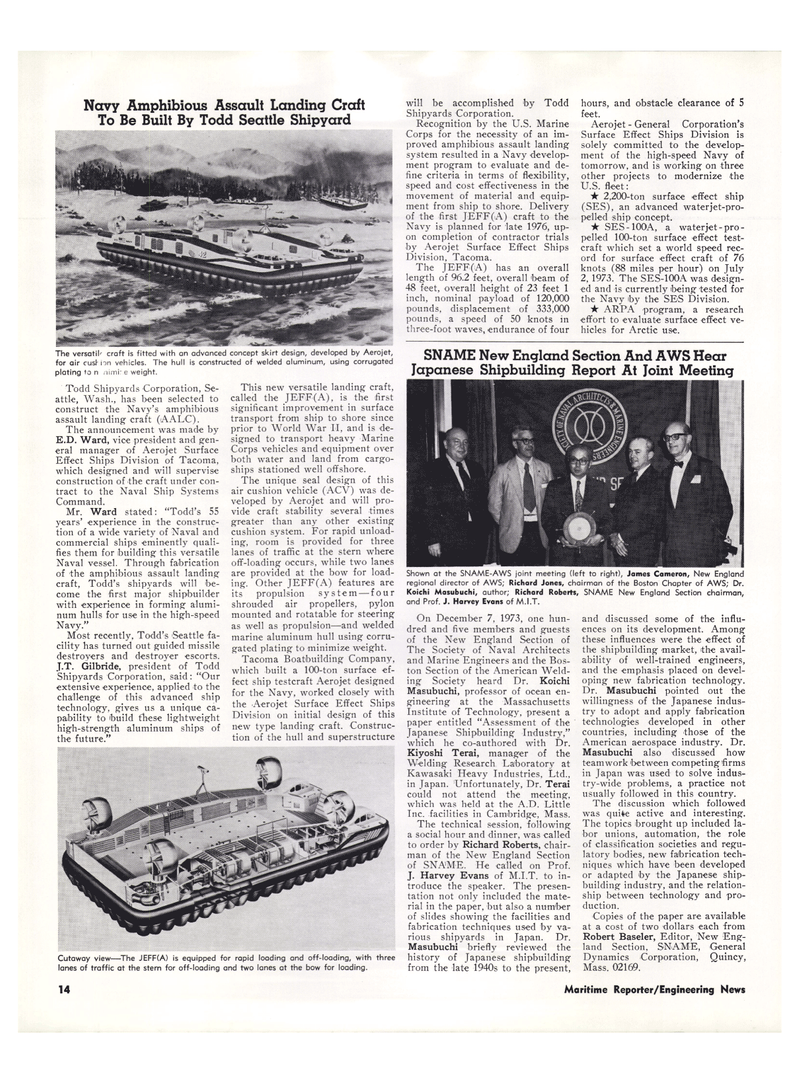
Page 12: of Maritime Reporter Magazine (January 15, 1974)
Read this page in Pdf, Flash or Html5 edition of January 15, 1974 Maritime Reporter Magazine
Navy Amphibious Assault Landing Craft
To Be Built By Todd Seattle Shipyard
The versatil' craft is fitted with an advanced concept skirt design, developed by Aerojet, for air cushion vehicles. The hull is constructed of welded aluminum, using corrugated plating *o n nimi: e weight.
Todd Shipyards Corporation, Se- attle, Wash., has been selected to construct the Navy's amphibious assault landing craft (AALC).
The announcement was made by
E.D. Ward, vice president and gen- eral manager of Aerojet Surface
Effect Ships Division of Tacoma, which designed and will supervise construction of the craft under con- tract to the Naval Ship Systems
Command.
Mr. Ward stated: "Todd's 55 years' experience in the construc- tion of a wide variety of Naval and commercial ships eminently quali- fies them for building this versatile
Naval vessel. Through fabrication of the amphibious assault landing craft, Todd's shipyards will be- come the first major shipbuilder with experience in forming alumi- num hulls for use in the high-speed
Navy."
Most recently, Todd's Seattle fa- cility has turned out guided missile destroyers and destroyer escorts.
J.T. Gilbride, president of Todd
Shipyards Corporation, said: "Our extensive experience, applied to the challenge of this advanced ship technology, gives us a unique ca- pability to build these lightweight high-strength aluminum ships of the future." will be accomplished by Todd
Shipyards Corporation.
Recognition by the U.S. Marine
Corps for the necessity of an im- proved amphibious assault landing system resulted in a Navy develop- ment program to evaluate and de- fine criteria in terms of flexibility, speed and cost effectiveness in the movement of material and equip- ment from ship to shore. Delivery of the first JEFF (A) craft to the
Navy is planned for late 1976, up- on completion of contractor trials by Aerojet Surface Efifect Ships
Division, Tacoma.
The JEFF ( A) has an overall length of 96.2 feet, overall beam of 48 feet, overall height of 23 feet 1 inch, nominal payload of 120,000 pounds, displacement of 333,000 pounds, a speed of 50 knots in three-foot waves, endurance of four hours, and obstacle clearance of 5 feet.
Aerojet - General Corporation's
Surface Effect Ships Division is solely committed to the develop- ment of the high-speed Navy of tomorrow, and is working on three other projects to modernize the
U.S. fleet: •k 2,200-ton surface effect ship (SES), an advanced waterjet-pro- pelled ship concept. ~k SES-100A, a waterjet-pro- pelled 100-ton surface effect test- craft which set a world speed rec- ord for surface effect craft of 76 knots (88 miles per hour) on Tuly 2, 1973. The SES-100A was design- ed and is currently being tested for the Navy by the SES Division. ~k ARPA program, a research effort to evaluate surface effect ve- hicles for Arctic use.
SNAME New England Section And AWS Hear
Japanese Shipbuilding Report At Joint Meeting
This new versatile landing craft, called the JEFF(A), is the first significant improvement in surface transport from ship to shore since prior to World War II, and is de- signed to transport heavy Marine
Corps vehicles and equipment over both water and land from cargo- ships stationed well offshore.
The unique seal design of this air cushion vehicle (ACV) was de- veloped by Aerojet and will pro- vide craft stability several times greater than any other existing cushion system. For rapid unload- ing, room is provided for three lanes of traffic at the stern where off-loading occurs, while two lanes are provided at the bow for load- ing. Other JEFF(A) features are its propulsion system — four shrouded air propellers, pylon mounted and rotatable for steering as well as propulsion—and welded marine aluminum hull using corru- gated plating to minimize weight.
Tacoma Boatbuilding Company, which built a 100-ton surface ef- fect ship testcraft Aerojet designed for the Navy, worked closely with the Aerojet Surface Effect Ships
Division on initial design of this new type landing craft. Construc- tion of the hull and superstructure
Shown at the SNAME-AWS joint meeting (left to right), James Cameron, New England regional director of AWS; Richard Jones, chairman of the Boston Chapter of AWS; Dr.
Koichi Masubuchi, author; Richard Roberts, SNAME New England Section chairman, and Prof. J. Harvey Evans of M.l.T.
Cutaway view—The JEFF(A) is equipped for rapid loading and off-loading, with three lanes of traffic at the stern for off-loading and two lanes at the bow for loading.
On December 7, 1973, one hun- dred and five members and guests of the New England Section of
The Society of Naval Architects and Marine Engineers and the Bos- ton Section of the American Weld- ing Society heard Dr. Koichi
Masubuchi, professor of ocean en- gineering at the Massachusetts
Institute of Technology, present a paper entitled "Assessment of the
Japanese Shipbuilding Industry," which he co-authored with Dr.
Kiyoshi Terai, manager of the
Welding Research Laboratory at
Kawasaki Heavy Industries, Ltd., in Japan. Unfortunately, Dr. Terai could not attend the meeting, which was held at the A.D. Little
Inc. facilities in Cambridge, Mass.
The technical session, following a social hour and dinner, was called to order by Richard Roberts, chair- man of the New England Section of SNAME. He called on Prof.
J. Harvey Evans of M.l.T. to in- troduce the speaker. The presen- tation not only included the mate- rial in the paper, but also a number of slides showing the facilities and fabrication techniques used by va- rious shipyards in Japan. Dr.
Masubuchi briefly reviewed the history of Japanese shipbuilding from the late 1940s to the present, and discussed some of the influ- ences on its development. Among these influences were the effect of the shipbuilding market, the avail- ability of well-trained engineers, and the emphasis placed on devel- oping new fabrication technology.
Dr. Masubuchi pointed out tbe willingness of the Japanese indus- try to adopt and apply fabrication technologies developed in other countries, including those of the
American aerospace industry. Dr.
Masubuchi also discussed how teamwork between competing firms in Japan was used to solve indus- try-wide problems, a practice not usually followed in this country.
The discussion which followed was quite active and interesting.
The topics brought up included la- bor unions, automation, the role of classification societies and regu- latory bodies, new fabrication tech- niques which have been developed or adapted by the Japanese ship- building industry, and the relation- ship between technology and pro- duction.
Copies of the paper are available at a cost of two dollars each from
Robert Baseler, Editor, New Eng- land Section. SNAME, General
Dynamics Corporation, Quincy,
Mass. 02169. 14 Maritime Reporter/Engineering News

 11
11

 13
13
